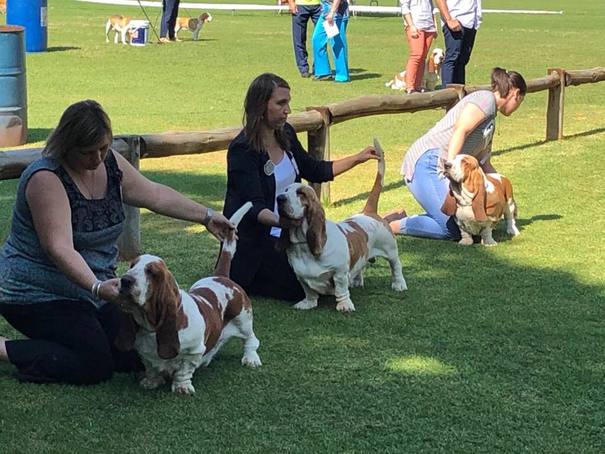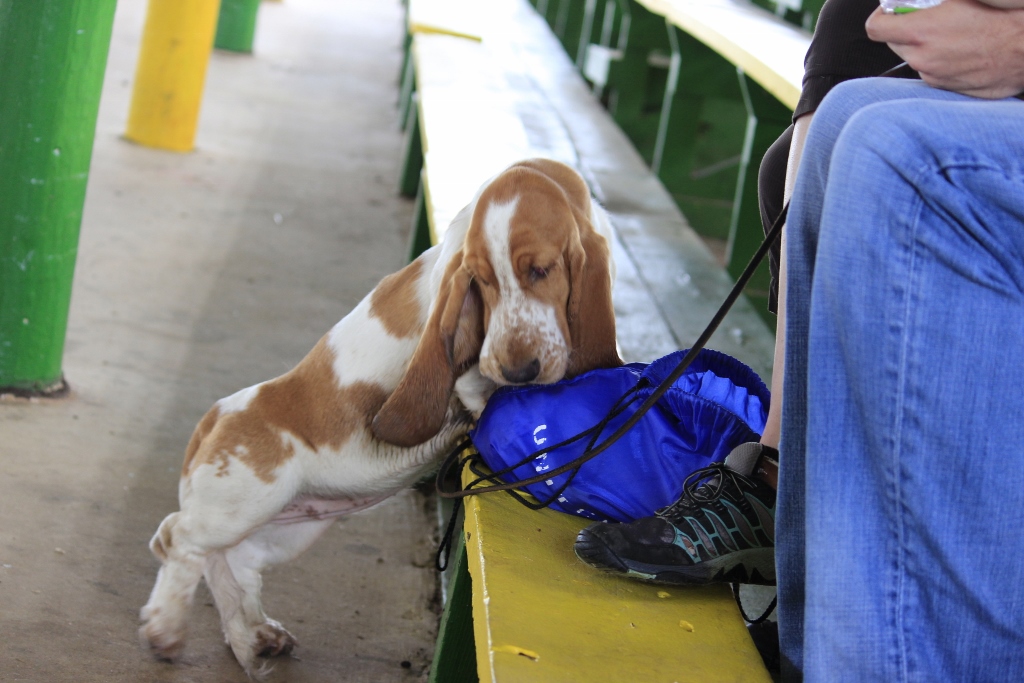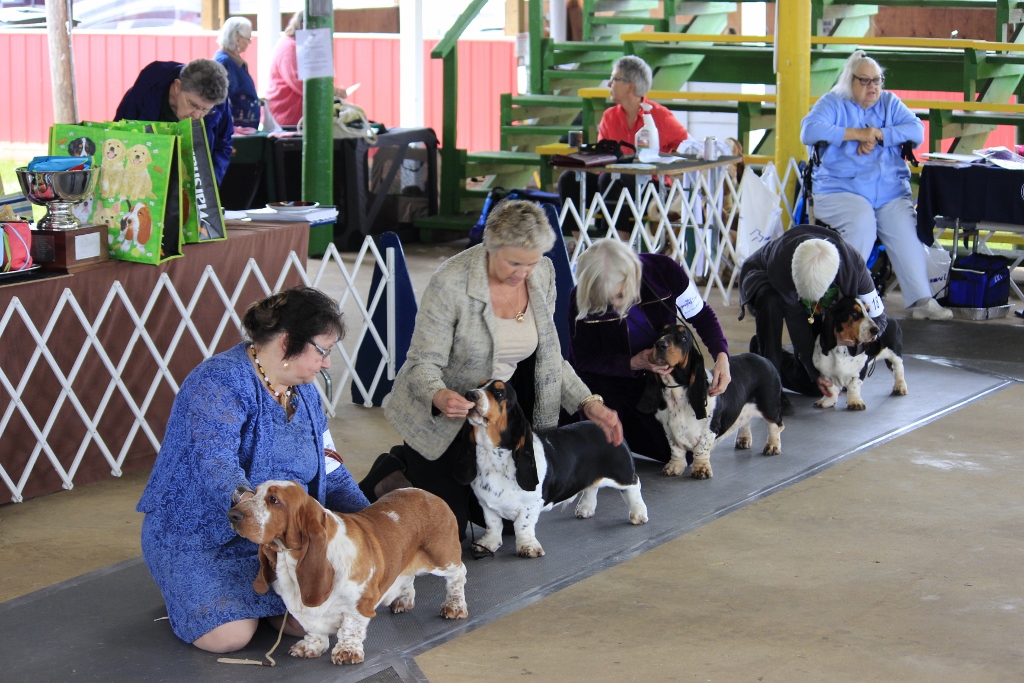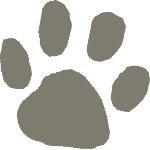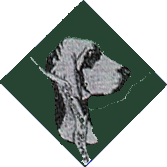
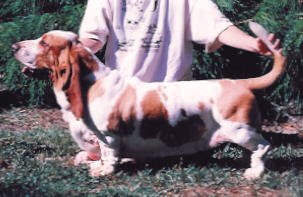
Basset Hounds are descended from the old St. Hubert hounds. Used to trail and hunt game, the Basset has had such famous admirers as King Edward VII and Shakespeare. The Basset was bred for hunting small game. The Basset’s long ears were developed to stir up and hold the scent for their strong nose to smell. The folds of skin under the chin, called the dewlap, help trap and hold the scent. Wrinkles about the head and face also aid in holding the scent. Their large feet make them steady and the heavy bones make them sturdy. Their short legs are ideal for slow trailing. This allows hunters to follow on foot. The Basset is used primarily to hunt rabbit although they were first used on other small game such as pheasant.
The Basset Hound is one of the best dogs available for a family to love. They are extremely tolerant and love everyone in the family equally. They are a very gentle, sweet, loyal and affectionate breed, although they are quite stubborn at times. They get along well with other pets of various species. They are not an aggressive watchdog but will learn to give a deep bark as a warning if praised when sounding off. Otherwise, they will accept visitors with a sniff and return to a favorite corner. The Basset Hound is a versatile pet who will play with children, make a skilled hunter, and sit by their owner’s side during quiet times.
The male Basset Hound at maturity usually weighs between 55 and 75 pounds, and stands 12, to not more than 15 inches tall at the shoulder. They are a big dog on short legs. The female is usually about 10 pounds lighter and 1 inch or so shorter than the male. Make no mistake, the Basset grows to be a good size dog, weighing more than most people expect, due to their heavy bone. As a young dog they need a consistent, firm, (but not harsh) hand so they will learn not to jump on people. They are not lap dogs, even though they may think so. The Basset has a large, well-proportioned head, sad, droopy eyes with a prominent haw; and long, low-set ears and loose facial skin and dewlap. A muscular neck and shoulders arch above a powerful chest, and the stubby legs are tipped with huge paws. The low-slung, loose-skinned, body is accented by a tail carried gaily in an upswept arc.
Basset Hounds have gentle dispositions. They were bred to be pack dogs and to get along with each other. This makes the male as friendly, mild, and easy to live with as the female. Males are not as aggressive as some other breeds of dogs, and they are usually not as prone to “marking” their territory unless there is an unneutered male around.
Some Basset Hounds have a tendency to howl when left alone for long periods of time. They will also wander away from home if not kept in a (securely locked) fenced area. The Basset is so good with children, and often found in homes with them. Great care MUST be taken to assure that gates cannot be left open accidentally when children enter and leave a fenced area. When a good scent reaches their nose, there is no telling where they will end up. Unfortunately, the Basset is not good at finding the way home. A responsible owner keeps his Basset as safe from harm as he would any other cherished pet. A Basset with its large deep flews can also be more slobbery than other breeds.
Adult Basset Hounds generally eat between two and four cups of food per day. (Many dog food labels have you over-feeding your dogs.) Bassets often have a tendency to get fat, partly because their sad look lends their owners to “take pity on them” and give them more food than they require. Overeating is dangerous to all dogs. Puppies, depending on their age, will eat from two to four meals per day in proportion to their size. You should avoid feeding your Basset fad foods. Feed only a well-balanced, name brand dry food supplemented with a quality canned food and/or other supplements. Many canine nutrition experts feel that vitamin supplements are not needed when using a top quality name-brand dog food. If a vitamin is used, care must be taken to avoid over-supplementing. Check with your veterinarian to see what is best for your dog. Generally, store or generic brand dog foods should not be used. A pregnant female Basset gradually requires more food and a supplement as recommended by your veterinarian.
The Basset Hound does not need fussy coat care as the hard, short coat repels dirt and water rather well. However, they should be brushed weekly to remove any loose hair and dirt. Shedding can be kept to a minimum if brushed regularly. The Basset Hound needs a bath only four to six times a year because a good rubdown with a coarse cloth or a hounds glove will remove a great deal of dirt and bring a shine to the coat.
Regular grooming helps create a bond between owner and pet. Wipe out the insides of the ears once a week with a solution recommended by your veterinarian. The Basset’s heavy ear leather prevents loss of moisture from inside the ear, and if not cleaned out, odor and/or infection can result. Clean the outside of the ears too. Trim the nails every 1-3 weeks. This allows the dog to walk correctly on his feet and properly support his heavy weight. Puppies need more frequent clipping than an adult. If you hear the nails click on the floor, they need to be cut. Have your veterinarian or breeder show you how to clip your dog’s nails correctly. Clean your Basset’s teeth with a soft toothbrush and water/doggie toothpaste to prevent plaque buildup. Anal glands can produce unpleasant odors. You may want your veterinarian to show you the proper procedure for anal gland care as another means of keeping your dog odor-free and comfortable.
The Basset Hound enjoys excellent health. He is not prone to many hereditary weaknesses that are present in some other breeds. Most of the health problems which might occur can be attributed to the owner because the dog was allowed to become overweight. This may result in aggravated arthritis, back problems, or heart trouble. Physical fitness is as important to the Basset as it is to humans. The Basset Hound being an endurance dog, enjoys running and leading an active life. Dogs raised in areas of the country where they can participate in the popular sport of field trialing can enjoy particularly good fitness.
All breeds can carry genetic disorders or hereditary faults. The following list includes some of the problems which might possibly develop in Bassets: Von Willebrand’s Disease – a platelet/bleeding disorder; Glaucoma – a buildup of pressure within the eye; Bloat – a swelling of the stomach, considered a life-threatening emergency; panosteitis – wandering, transient lameness, seen in young dogs, and usually outgrown by 2 years of age; allergies to some grasses; and smelly dirty ear canals, easily prevented with regular cleaning.
A purebred, pet quality Basset Hound puppy may cost anywhere from $650 up. (With the norm being up.) The price for a puppy with show quality potential will start appreciably higher. The price will vary according to age, geographic region of the country, and availability. The puppy should have been checked by a veterinarian and given appropriate inoculations based on it’s age. Inoculations for rabies, distemper, leptospirosis, hepatitis, kennel cough, and parvovirus are all necessary. A conscientious breeder will have a complete record of all puppy illnesses, treatments, and inoculations. Beware of a breeder who sells a puppy without all the necessary shots or proper AKC registration information – “papers”.
Given good care, the Basset can lead a very active 10 years and be active as a stud dog up to 12 years. Bassets enjoy their food in old age and, if allowed, become fat and lazy. The Basset is easy to keep, a steady hound and usually lives 8 to 12 years, although there are many that live beyond, to 14,15,16 or even up to 17 years.
Once determining that your dog or bitch is worthy of being bred the owners of the dog(s) should also consider following:
No harder than any other breed, however, you MUST be consistent.
Only with a great deal of difficulty. With 2/3 of the Basset’s weight in the front, and with such short legs, they can swim only very short distances, and with great difficulty. If you must go boating with a Basset be certain, you have provided the dog with a life preserver or other suitable floatation device. Extra care must be taken around swimming pools, and the Basset should never be left unsupervised in a pool area. Should your Basset be prone to falling in, teach him to swim to the stairs, so that he will learn the way out.
The value of a Basset should not be based on its color or markings. The tri-color is the most common, followed by the red & white. Tri’s at times can appear to be black and white, but on closer inspection, a touch of brown usually can be found. Red & whites can be almost completely white with just a few spots of tan, or they can be a deep mahogany color with only a small amount of white. Most come somewhere in between. There are also lemon & whites. A true lemon is rarely seen. Their markings are mostly white that fades into areas of very, very light tan. To tell if it is a true lemon, the puppy, at birth is totally white with no hint of tan. The light tan color develops as they mature. It should also be noted that the color and coverage of the marking of the puppy you get at 10-12 weeks will change as they mature. Every once in a while, you will hear of someone advertising the “rare” blue Basset (actually it is gray). The standard states “any recognizable hound color is acceptable”, and blue is a recognized color in some other hound breeds, so it’s not illegal – but it is VERY undesirable. It is a recessive trait resulting in genetically inherited disorders associated with this color. Be wary of breeders selling these “blue” bassets. A reputable breeder would not involve themselves in purposely breeding inferior quality.
In the metropolitan Washington, D.C. area, including Virginia, West Virginia, Maryland, Delaware and Southern Pennsylvania, please contact the: POTOMAC BASSET HOUND CLUB, INC
